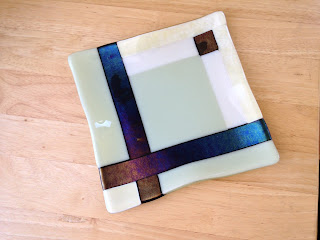Over the course of seven weeks in the glass studio this summer, I completed four pieces I’d worked on previously and created one brand new piece – my first commission!
The commission resulted from a meeting with a Mantua resident who saw my fused glass work at last May’s Mantua Made Market. She requested a piece for a specific location in her house and added that it should be a piece that could serve as a focal point. After an in-person visit to her house, where I took careful note of the color scheme (various shades of teal and turquoise, with gold metallic accents) and furnishings, I spent several weeks developing designs. I also experimented by making test pieces with different colors and types of glass. This was especially important since I wanted to take advantage of the reactive qualities of certain glass combinations. For example, you get an interesting effect when you place certain shades of blue and green glass colors next to the creamy white glass called French vanilla. The copper-containing blue or green glass reacts chemically with the sulfur/selenium-bearing French vanilla. In the final piece, which is a 12-inch square, I used French vanilla frit in several locations where it was adjacent to blue or green. I also tack-fired small puddles of coarse frit in the corners of the piece to create a raised texture.
I’m happy to say that the owner was delighted with the finished piece when I delivered it in August. The photo below shows how it fits in with the décor.
In addition, I finished work on a 12-inch square platter that taught me about the unpredictable qualities of Steel Blue opalescent glass. The glass I used was blue before firing. You can imagine my surprise when I got it out of the kiln after a full fuse firing and found that the glass was now steel gray! Since I wanted to restore the blue color, I sandblasted the entire piece, which got rid of the gray coating. A few other steps were involved before the final slumping. Next time I’ll know how to avoid this problem. The side that is against the clear Tekta glass remains blue. I will assemble the piece so that it will be flipped over after the full fuse firing.
Lastly, I slumped three small dishes that I’d previously made. Working in a small format gives me a chance to try new techniques while using up some of my glass scraps. In the first of the small dishes, I’ve used a piece of stringer that we made in the vitrograph.
In the second piece, I’ve used scraps of streaky glass (clear with black).
In the third piece, I used a stripe of rainbow iridized glass along with French vanilla and artichoke. The circle came from dot I made earlier in a beehive kiln.

















































